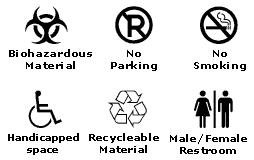Standards developed by international bodies
Standards have been developed by industrial, federal and international governing bodies for road signs, sports signs, dashboard symbols, household appliances, audiovisual equipment. Benefits of standards include interoperability,
compatibility, increase reliability, effectiveness, and to facilitate immediate recognition. Several standard for computers and graphical user interfaces are included below, however a standard has yet to be developed for
 Web icons. Until a standard is proposed, Web developers will have to continue to rely on
current somewhat inappropriate standards, typographic and symbol studies.
Web icons. Until a standard is proposed, Web developers will have to continue to rely on
current somewhat inappropriate standards, typographic and symbol studies.
The International Organization for Standardization (ISO) FAQ includes the following answer, "Take a look at the graphical symbols on
the dashboard of your car or at the pictorial symbol on a package marked with handling instructions such as "This way up". Various ISO technical committees have developed or adopted hundreds of carefully researched signs
and symbols that convey clear-cut messages which cross language bounderies."[1]
The ISO/IEC Guide 2:1996 defines a standard as a document, established by consensus and
approved by a recognized body, that provides, for common and repeated use, rules, guidelines or characteristics for activities or their results, aimed at the achievement of the optimum degree of order in a given context. [2]
International Standards Organization (ISO)
- ISO 9241 "Ergonomic Requirements for Office Work with Visual Display Terminals," produced by ISO Technical Committee 159, Signals and Controls Group 4, Working
Group 5 (TG159/SC4/WG5); covers many areas from task, keyboard, and workplace requirements, to guidance on dialogue design, menu design, and the use of color; part has been implemented in European legislation (Directive 87/391/EEC)
- ISO 14915 standard on multimedia, also produced by TC159/5C4/WG5; covers design of controls and navigation, media combination/individual media requirements, and domain-specific multimedia aspects
- ISO–lEG Joint Technical Committee 1 is a combined activity of ISO and the International Electrotechnical Commission. Working Group 9 of Subcommittee 18 is
developing standards in keyboard layout, dialogue interaction, and symbols. Its work includes the following:
- ISO–lEG 11581 "Graphical Symbols on Screens"
- ISO–lEG 13714 "User Interface to Telephone-Based Services—Voice Messaging Applications"
- ISO–lEG 11580 "Names and Descriptions of Objects and Actions Commonly Used in the Office Environment"
More information may be found at the
ISO Web site .
American National Standards Institute (ANSI)
- ANSI/HFES 200 "Ergonomic Requirements for Software User Interfaces" Extends ISO 9241, including a chapter on guidelines for making user interfaces usable for people
with disabilities of different kinds, written in response to the Americans with Disabilities Act.
- The Information Infrastructure Standards Panel (IISP) was set up under ANSI to accelerate the development of standards that will be crucial to the building of the
United States' national information infrastructure and the taking of a global perspective.
- ANSI T1M1.5 provides technical contributions on "Telecommunications Architecture, Interfaces, and Protocols" to Study Group 10 of the International Telecommunications Union (ITU)
- ITU
More information may be found at the
ANSI Web site.
Governing bodies that have introduced significant standards include;
- American Institute of Graphic Arts (AIGA)
- Society of Environmental Design (SEGD)
- U.S. Highway Signs (MUTCD)
- International Highway Signs (UNCRT)
- Recreational Symbol Signs (SEGD)
- Transportation Symbol Signs (AIGA/DOT)
- Transportation Symbol Signs (TCRP/DOT)
- International Electronic Labeling
- International Standards Organization (ISO)
- American National Standards Institute (ANSI).
Several computer organizations have offered standards for the interface including;
- Apple Computer - Human Interface Toolbox
http://developer.apple.com/techpubs/macos8/HumanInterfaceToolbox/humaninte rfacetoolbox.html
The MITRE Corporation, Smith and Mosier - Guidelines for Designing User Interface Software
Online as plain text or PostScript via anonymous ftp from ftp://ftp.cis.ohio-state.edu/pub/hci/Guidelines
Microsoft - Design Specifications and Guidelines - Visual Design, and Design of Graphic Images
http://msdn.microsoft.com/library/books/winguide/ch14f.htm
Also see Jakob Nielsen's essay
Assessing the Usability of a User Interface Standard for an overview of how standards are used (or not used) by developers.
 Sources:
Sources:
- International Organization for Standardization, ISO Frequently Asked Questions - Section 2.10,
http://www.iso.ch/infoe/faq.htm
World Standards Services Network, General Information on Standardization,
http://www.wssn.net/WSSN/gen_inf.htm
Developed by:

Page last modified on Saturday, August 19, 2000.
 Web icons. Until a standard is proposed, Web developers will have to continue to rely on
current somewhat inappropriate standards, typographic and symbol studies.
Web icons. Until a standard is proposed, Web developers will have to continue to rely on
current somewhat inappropriate standards, typographic and symbol studies.![]() Sources:
Sources:
![]()